
What Is the NFPA Diamond and Why Is It Important?
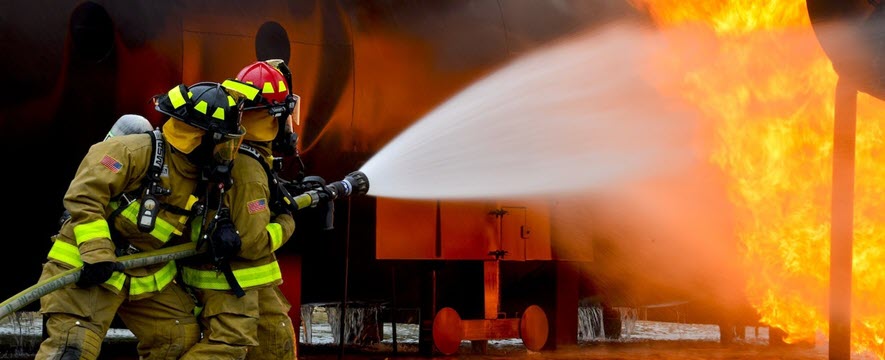
Firefighters must assess an emergency, such as a fire or a chemical spill, quickly to determine how to respond. Certain chemicals pose hazards when exposed to water or heat. The National Fire Protection Association set a standard called NFPA 704 to communicate chemical hazards to firefighters by use of a special sign, called the NFPA diamond. Facilities that store certain chemicals must display the NFPA diamond in case of a fire on the premises.
What Does the NFPA Diamond Look Like?
Because each side of the “fire diamond,” as it is sometimes called, is equal in length, another accurate way to refer to it is a “square-on-point” or a rotated square. In either case, it contains four quadrants, each of which represents a different hazard. Firefighters can identify the hazard both by the position of the quadrant within the diamond and its color. Each quadrant has a different color assigned to it.
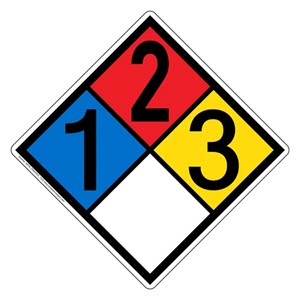
In three of the four quadrants, there is a number from zero to four. This number demonstrates the severity of the hazard. The fourth quadrant can contain a symbol representing a special hazard posed by the material.
What Do the Different Colors Mean?
The NFPA diamond uses a color code, with each color representing a different hazard:
Red – The red quadrant appears in the 12 o’clock position on the fire diamond. It represents flammability, or the likelihood that the material will catch on fire.
Blue – The blue quadrant appears on the fire diamond in the 9 o’clock position. It represents health hazards, i.e., whether exposure to the chemical can cause illness or injury.
Yellow – The yellow quadrant appears in the fire diamond’s 3 o’clock position. It represents the chemical’s reactivity, or the likelihood that it could explode.
White – The white quadrant appears in the 6 o’clock position and represents special hazards that the other three quadrants do not cover.
What Do the NFPA Diamond Ratings Mean?
To communicate the severity of each hazard, the red, blue and yellow quadrants each receive a numerical rating from 0 to 4. A lower number represents a lower risk, while a higher number represents a greater risk:
- 0: Minimal hazard
- 1: Slight hazard
- 2: Moderate hazard
- 3: Serious hazard
- 4: Severe hazard
The combination of the color-coded quadrant and the numerical code inside of it communicates quickly to firefighters the type of hazard they are facing and how severe it is. Here are some examples of what the combined colors and numbers mean:
Yellow 1: Slight stability hazard, i.e., a normally stable substance that can become unstable if exposed to elevated pressure or temperature
Red 0: Minimal flammability hazard, i.e., a substance that is not flammable
Blue 4: Severe health hazard, i.e., a highly toxic substance that can cause death under emergency situations
Yellow 4: Severe stability hazard, i.e., a substance that can explode at normal temperatures and pressures
Red 2: Moderate flammability hazard, i.e., a substance that may ignite when exposed to relatively high ambient temperatures or moderate heat
Common NFPA Diamond Signs
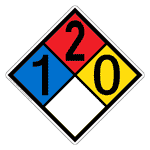 | 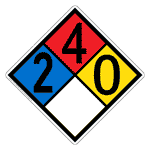 | 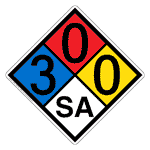 | 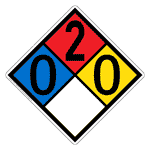 |
What Do the Symbols in the White Quadrant Mean?
The white quadrant of the NFPA diamond is for special hazards not covered by the other four quadrants. Unique symbols communicate these hazards to firefighters and first responders.
There are only three symbols that the NFPA has authorized to go into the white quadrant. However, some people use additional, unauthorized symbols.
NFPA Authorized Symbols
The symbols the NFPA has authorized to go into the white quadrant are: OX, representing a substance that oxidizes; SA, indicating a simple asphyxiant gas; and a struck-through W, representing a substance that reacts with water.
While not itself explosive, an oxidizer can accelerate the explosion of a combustible material if the two come into contact.
A simple asphyxiant gas can push the oxygen out of the air. Low levels of oxygen can cause a person to suffocate. This symbol can only go on certain gases:
- Argon
- Helium
- Krypton
- Neon
- Nitrogen
- Xenon
Other gases may be asphyxiant but are not simple.
Water is a common ingredient in most firefighting substances. However, certain materials react strongly to water. For example, exposure to water causes sodium to combust. Therefore, using water to fight a sodium fire would feed the flames rather than extinguish them.
Non-Authorized Symbols
There are other symbols that, while not receiving authorization, nevertheless show up frequently in the white quadrant of the NFPA diamond. Examples of these non-authorized symbols include the following:
- ACID: Acidic
- ALK: Alkaline
- COR: Corrosive
Some people also use symbols in the white quadrant representing radioactivity or biohazard, if applicable.
While it is not illegal to use unauthorized symbols in the white quadrant, there are issues that can arise from it. First, firefighters receive training on reading the authorized symbols. If an unauthorized symbol appears, they might not understand what it means or waste valuable time trying to decipher it. The other issue is that many of the unauthorized symbols are unnecessary because they cover hazards communicated in the other three quadrants.
When and Where Do Facilities Have To Use the NFPA Diamond?
The NFPA 704 standard only tells facilities how to label hazardous materials. It does not specify when labeling is required. For this information, facilities must look to applicable local, state or federal regulations. Some facilities choose to use the fire diamond even when there is no legal requirement, and this is acceptable as long as they use the labels correctly.
Facilities that use NFPA 704 placards should place them at every entry point where firefighters could potentially enter the facility. If there are multiple possible entry points, placards need to appear at each one.
There is no set size for NFPA placards featuring the fire diamond. Rather, the placards must be large enough to be legible. The 704 standard provides guidance on placard sizing based on the distance at which firefighters and first responders will read them.

